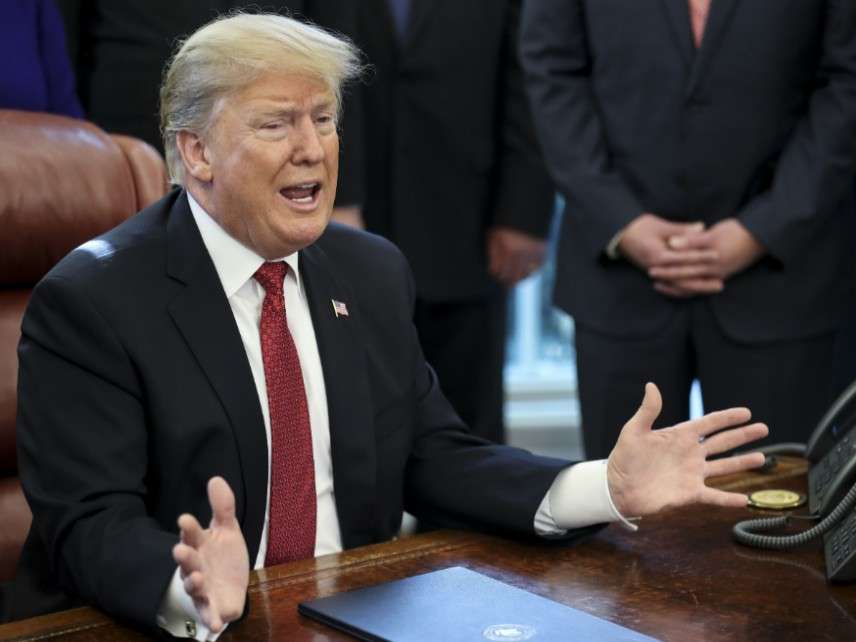Trump's First National Drug Control Strategy Reads Like a High School Book Report Written 30 Minutes Before Class
Does anyone still work at the Office of National Drug Control Policy?

Since the Anti-Drug Abuse Act was passed in 1988, every presidential administration has been required by law to publish a document each year outlining its plans for addressing illicit drug use.
After spending the first two years of Donald Trump's presidency in limbo, the Office of National Drug Control Policy (ONDCP) has released its first congressionally mandated report since the Obama era.
Not counting the cover page, the table of contents, or the opening letter from Drug Czar James W. Carroll, the 2019 National Drug Control Strategy is 20 pages long. For comparison's sake, the 1992 National Drug Control Strategy ran 182 pages, not counting the introduction or index. (And no, the 2019 report does not contain an index.) The 2016 National Drug Control Strategy was 87 pages.
The 2019 National Drug Control Strategy is like a book report from a student who may or may not have read the book, and who may or may not have written his report on the bus ride to school.
That said, it does contain some food for thought.
What's new for 2019? Broadly speaking, not much.
As was the case under Barack Obama, Trump's 2019 report focuses on reducing demand by informing the public about the dangers of illicit drug use, micromanaging prescribers in order to reduce opioid availability, increasing the availability of drug treatment options, and cracking down on the illicit drug trade. And by "focuses," I mean the report mentions these things.
What's specifically different from years prior? Marijuana and kingpins.
Previous National Drug Control Strategies generally contained lengthy sections on marijuana. But in keeping with the recent trend toward state-level legalization, Trump's 2019 report focuses only on reducing underage cannabis consumption (via grants to state and local organizations), interdiction of marijuana trafficked from overseas and Latin America, and cracking down on marijuana cultivation on public lands.
In total, the word "marijuana" appears only four times in the 2019 strategy, while the word "opioid" appears 53 times. There is no suggestion in this report that the Trump administration plans to undermine state-level legalization efforts. This is a good thing!
Watchers of the drug war in Latin America may also be surprised to learn that the report contains some subtle criticism of what's called the "kingpin strategy," which, for two decades now, has seen U.S. and Latin American law enforcement agencies focused on identifying and arresting the leaders of drug trafficking organizations (DTOs). Critics of this approach have shown for years that taking out cartel leaders causes DTOs to fracture, factionalize, and fight for territory and control, which leads to more violence and political destabilization and corruption. The 2019 Drug Control Strategy is the first report I've seen that sorta-kinda acknowledges this consequence:
Our conventional focus on targeting high-level individuals within the hierarchy of well-organized and sophisticated DTOs must evolve toward identifying and targeting vulnerable critical components of more fluid and dynamic organizations such as financial facilitators, corrupt officials, and key transporters, to affect a significant disruption of DTO activities, targeting key nodes to attack the entire network through its enablers.
Degrading and defeating criminal networks that have become more resilient because they are decentralized, redundant in capabilities and capacities, and compartmentalized, requires identifying the key nodes enabling DTO operations and simultaneously targeting them for maximum effectiveness over time. Agile interagency and international coordination will allow for better detection of changes in the trafficking supply chain, which will support intelligence-driven operations against identified vulnerabilities, from drug production to delivery to the end user.
Unfortunately, the 2019 report does not tell us what the administration thinks the U.S. should be doing instead. We know the Drug Enforcement Administration continues to operate in Latin America, but it is not clear from this report that the ONDCP or the White House is overseeing or coordinating those activities.
What are the goals of the 2019 Drug Control Strategy?
In short: "Do everything we've always done, only better!"
Here are the actual "measures of effectiveness":
- The number of Americans dying from a drug overdose is significantly reduced within five years
- Nationwide opioid prescription fills are reduced by one-third within three years, and within five years all healthcare providers have adopted best practices for opioid prescribing
- Evidence-based addiction treatment, particularly Medication-Assisted Treatment for opioid addiction, is more accessible Nationwide for those who need it
- The production of plant-based and synthetic drugs outside the United States has been significantly reduced, illicit drugs are less available in the United States as reflected in increased price and decreased purity, and drug seizures at all U.S. ports of entry increase each year over five years
The phrases "significantly reduced" and "more accessible" are pretty sly! We should expect the administration to take credit for any decrease in overdose deaths, even if there's no way to prove a causal effect. This is the prerogative of every president, of course.
The continued emphasis on controlling prescriber behavior remains troubling. (See Jacob Sullum on the disastrous consequences of punishing doctors for helping people.)
I should add that striving for "increased price and decreased purity" is essentially how we arrived at the fentanyl crisis. Federal regulations made prescription pills harder to come by, so consumers turned to street drugs, which are notoriously impure. Countries that have seen street drug shortages, meanwhile, saw consumers turn to other street drugs or to even more impure formulations of the newly scarce drug. The report is at least right that reducing supply drives up costs and decreases purity, but this is not a good thing.
With the exception of a relaxed attitude toward domestic marijuana production, the federal drug war appears to be the same as it ever was.


Show Comments (47)